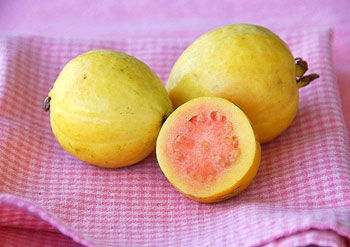 What is the complete opposite of Christmas cookies? I just did some research; turns out that the complete opposite of a Christmas cookie is a strawberry guava. It's no wonder this sexy fruit is native to Brazil, the land of beautiful bronzed bodies and gorgeous beaches. Everything about a strawberry guava says, "look at me."
What is the complete opposite of Christmas cookies? I just did some research; turns out that the complete opposite of a Christmas cookie is a strawberry guava. It's no wonder this sexy fruit is native to Brazil, the land of beautiful bronzed bodies and gorgeous beaches. Everything about a strawberry guava says, "look at me."
Eating a strawberry guava is a memorable sensory experience. First it entices you with its intoxicating perfume of ripe summer strawberries and tart pink grapefruit. Its butter cup yellow rind is smooth and soft to the touch, evoking warmth and sunshine. One bite of a strawberry guava will make you understand why it's called "exotic." The creamy, fruity flesh is the color of roses, while the flavor is a beautiful combination of tangy, sweet grapefruit, juicy, ripe strawberries, and late summer grapes.
Most U.S. guavas are grown in Hawaii and Florida, though the strawberry guavas you see here were grown in Southern California and generously given to me by our friend, Adel. These strawberry guavas have a pastel yellow skin yet also come in bright red or deep purple. When buying strawberry guavas or any variety of guava really, look for a fragrant fruit that is free of blemishes and soft to the touch. Hold it in your hand, and give it a gentle squeeze; it should give slightly, being neither too hard nor too squishy.
Christmas
Christmas
The Wife I Always Wanted, Part 2: Do Cubans Eat Geese?
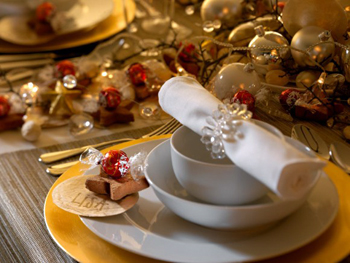 I’m nervous. I’m not sleeping well. The greatest challenge of my life is one month away and I have yet to start planning it: Christmas dinner. Everything will be riding on it. Not just my self-respect; the respect of my gender – every man who has ever said to his stay at home wife, “Hey, I’d take your job in a minute.” Well, she gave it to me. It’s all mine. And now I’ve got to deliver. Put a stunning meal on the table this Christmas; one that lets my hard working, career-driven wife know she married the right …well …wife.
I’m nervous. I’m not sleeping well. The greatest challenge of my life is one month away and I have yet to start planning it: Christmas dinner. Everything will be riding on it. Not just my self-respect; the respect of my gender – every man who has ever said to his stay at home wife, “Hey, I’d take your job in a minute.” Well, she gave it to me. It’s all mine. And now I’ve got to deliver. Put a stunning meal on the table this Christmas; one that lets my hard working, career-driven wife know she married the right …well …wife.
Let me be frank. I’ve survived these last few months on nothing but moxie, a crock-pot, and a copy of Cooking for Idiots. And now I’m staring at one hard cold fact: not only have I never cooked a Christmas dinner, I can’t recall having eaten one. I’m a Jew: a Jew, who pompously volunteered to cook for his Cuban wife and her family on their most important Holiday of the year. What the hell was I thinking? If some couch potato wants to firm up, you don’t tell him to enter a marathon. You tell him to walk a little, then jog a bit, see if he can eventually work himself up to a mile. Yet here I am, a couch potato running a marathon, a culinary novice planning the mother of all meals: Christmas Dinner. Yikes!
Xmas on Your Doorstep
We asked some of our contributors to tell us their favorite things that come in the mail at Xmas. We always think that one of the nicest things to do, if you can’t be with someone at the holidays, is to send something that can be part of their holiday meal, Xmas dinner, Xmas breakfast. A favorite jam, a basket of muffins, crab cakes, caviar (although this may not be the year for that), an apple pie, candleholders, a smoked ham or turkey, or even barbecued brisket!
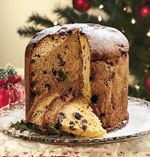 Every Christmas, we receive a large Italian Panettone Cake
Every Christmas, we receive a large Italian Panettone Cake from Dino and Martha De Laurentiis. It looks good in its elaborate wrapping, and tastes good, too, especially as French toast. But the reason we love it so much has more to do with its power to remind us - like a photograph - of the many evenings we’ve spent with this remarkable family - here in LA, in Florence, and, on the eve of the Millennium in, of all places, the South Pacific.
– Steven Zaillian
![]() My sister in law gave me a Microplane Grater
My sister in law gave me a Microplane Grater as a Christmas present a few years ago, and I use it constantly. It's wand shaped, which makes it really fun to use. Sometimes I like to pretend it's a violin bow while I zest lemons and such. It also has a scabbard, and that's cool. The best thing about it is that your arm doesn't get tired, but your parmesan turns into fluffy, salty snow. It would fit nicely in a stocking, and you should seriously get one if you haven't already.
– Agatha French
Besides wine, the best gift we get every year is a 6-pk of petite filets from Omaha Steaks. They are the perfect size for relatively guilt-free meat consumption and are always tender and delicious regardless of how rare or well-done you like yours cooked. They turn a regular steak dinner into something special.
– Lisa Dinsmore
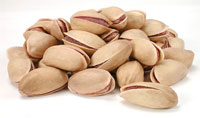 I have a friend who sends me a bag of California Pistachios
I have a friend who sends me a bag of California Pistachios each year and it has become one of the highlights of the holiday season for me. While others herald the arrival of mail at this time of year, bringing cards and letters from family and friends, I anxiously await the postman's delivery of a package filled with these delicious nuts. I don't know what it is about them (they're a pain in the neck to open and I don't eat them at any other time during the year), but to me the arrival of the pistachios (like the lighting of the tree at Rock Center or the first of a gazillion broadcasts of IT'S A WONDERFUL LIFE) lets me know that the holidays have truly begun.
– Seale Ballenger
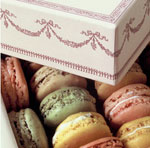 A beautiful box of Ladurée Macaroons to share with your sweetheart over a pot of Darjeeling tea and great conversation... That is what I would like my FedEx driver to deliver. (Just the Macaroons.)
A beautiful box of Ladurée Macaroons to share with your sweetheart over a pot of Darjeeling tea and great conversation... That is what I would like my FedEx driver to deliver. (Just the Macaroons.)
– Brenda Athanus
 Pretty much every Christmas since the start of the Bush administration, (though I still haven’t figured out the connection), someone gave me a fabulous apron
Pretty much every Christmas since the start of the Bush administration, (though I still haven’t figured out the connection), someone gave me a fabulous apron. The blue one with the white polka dots, for example, is from Amy; the sheer, short vintage one with the letter “M” embroidered on the right breast – a gift from my stepdaughter Sal; the white-on-white striped one with the pink rickrack and the yellow, green, purple and rose circles – courtesy of my niece Jennifer. The point is not that I don’t have any; the issue with me and aprons is that I don't put one on til after the barn door is closed. When de Kooning dots of marinara dribble from my tasting spoon onto my best white blouse (the one with the trumpet sleeves, and I still don’t know how that happened because I swear I was holding that spoon right over the pot), after Rorschach blots of dark brown gravy appear on my favorite navy crepe dress, as a constellation of hot caramel from the Tarte Tatin splatters from my cast iron skillet onto my red cashmere cardigan – only then do I decide to tie on an apron. This is not good. This is not why God invented them. If only someone would call and remind me that in a battle between Minestrone and me, the Minestrone will always win – now that would be a perfect Christmas present.
– Katherine Reback
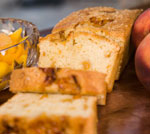 The best peach bread you will ever put in your mouth is from the shop Breadwinner. It is the gift I give all my friends who have everything. It has been featured on the "Today Show," among others. I am lucky I live down the street from the store. Trust me, order it and and you will become addicted. Everything they have is one of a kind but I truly adore their peach bread.
The best peach bread you will ever put in your mouth is from the shop Breadwinner. It is the gift I give all my friends who have everything. It has been featured on the "Today Show," among others. I am lucky I live down the street from the store. Trust me, order it and and you will become addicted. Everything they have is one of a kind but I truly adore their peach bread.
– Laura Johnson
![]() What I like to receive during the holiday season is a small shovel
What I like to receive during the holiday season is a small shovel that I can use to dig a hole in my backyard and bury all the holiday cakes, candy and long interminable accounts of what the year was like for everyone in their family that are sent our way.
– Alan Zweibel
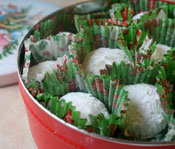 My college roommate's mother bakes the most delicious Mexican wedding cookies in the world and every Christmas sent us a care package full of cookie tins all carefully labelled in her elegant handwriting. We weren't exactly good little girls in college, but we still managed to earn Mrs. Hinojosa's cookies. I would like to repeat college for a variety of reasons; receiving these cookies every year would be chief among them.
My college roommate's mother bakes the most delicious Mexican wedding cookies in the world and every Christmas sent us a care package full of cookie tins all carefully labelled in her elegant handwriting. We weren't exactly good little girls in college, but we still managed to earn Mrs. Hinojosa's cookies. I would like to repeat college for a variety of reasons; receiving these cookies every year would be chief among them.
– Emily Fox
My husband and I love the Chesapeake Crab package...when it arrives I call my doctor/friend who comes over and both our families drink wine and dine on the crabs.
– Susan Dolgen
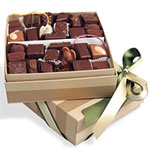 I am like a child when I get food in the mail (to the extent that I have been known to fight with my son over who gets to open the package), and I have to admit that I'm always disappointed when it isn't chocolate. The best food gift I've received was a one-pound box of assorted chocolates from L.A. Burdick's, a superb chocolatier based in New Hampshire. Their handmade bonbons are beautiful to look at and delicious. I savored that box for a long time – and I even shared.
I am like a child when I get food in the mail (to the extent that I have been known to fight with my son over who gets to open the package), and I have to admit that I'm always disappointed when it isn't chocolate. The best food gift I've received was a one-pound box of assorted chocolates from L.A. Burdick's, a superb chocolatier based in New Hampshire. Their handmade bonbons are beautiful to look at and delicious. I savored that box for a long time – and I even shared.
– Andrea Pyenson
I love getting bar-yochi, those carob bars because they're the sweetest, most delic treats on earth, bar-none!
– David Israel
 The best food thing I've ever gotten in the mail: a delectable assortment of gourmet brownies from Fairytale Brownies, which Random House Films sent me once the contracts were signed. They were rich and decadent, individually packaged little brownies in flavors like toffee crunch, peanut butter, pecan, and caramel, and the lovely sparkling fairytale packaging just added to the magical feel of it. Really, imagine opening a box and being confronted with chocolate and fairies. There is nothing better!!!
The best food thing I've ever gotten in the mail: a delectable assortment of gourmet brownies from Fairytale Brownies, which Random House Films sent me once the contracts were signed. They were rich and decadent, individually packaged little brownies in flavors like toffee crunch, peanut butter, pecan, and caramel, and the lovely sparkling fairytale packaging just added to the magical feel of it. Really, imagine opening a box and being confronted with chocolate and fairies. There is nothing better!!!
– Carolyn Turgeon
I think everyone could use cute heart shaped Alessi Coffee & Tea Spoons!
– Maia Harari
 Although it is always a nice surprise to get something edible in the mail during the holiday season I love to give and receive kitchen utensils, equipment, and gadgets as gifts. One year a box from my sister arrived with an Italian espresso maker and to this day every time I make a piping hot cappuccino or espresso shot I am reminded of her generosity. Cookware and electronic or technical equipment are a welcome addition to any home and make a lasting impression in their utility. In my experience, kitchens could always use an upgrade or expansion and the holiday season is a perfect excuse to shop for yourself and others, especially if it means new Le Creuset
Although it is always a nice surprise to get something edible in the mail during the holiday season I love to give and receive kitchen utensils, equipment, and gadgets as gifts. One year a box from my sister arrived with an Italian espresso maker and to this day every time I make a piping hot cappuccino or espresso shot I am reminded of her generosity. Cookware and electronic or technical equipment are a welcome addition to any home and make a lasting impression in their utility. In my experience, kitchens could always use an upgrade or expansion and the holiday season is a perfect excuse to shop for yourself and others, especially if it means new Le Creuset cookware!
– Jackson Malle
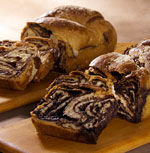 One year my best pal in NY sent me a large hunk of Barney Greengrass' whitefish and several chocolate babka muffins to appease my eternal, if lowgrade, homesickness for NY (yes, I am the living cliche after almost thirty years in LA). Then, just when I thought such a gift could not be out done, I received three huge pieces of Zabar's herring with cream and onions, a half-pound of nova, a few H&H bagels and cream cheese, and a Zabar's entire chocolate babka from my step-mother. I was supposed to share with my husband. Not a chance!
One year my best pal in NY sent me a large hunk of Barney Greengrass' whitefish and several chocolate babka muffins to appease my eternal, if lowgrade, homesickness for NY (yes, I am the living cliche after almost thirty years in LA). Then, just when I thought such a gift could not be out done, I received three huge pieces of Zabar's herring with cream and onions, a half-pound of nova, a few H&H bagels and cream cheese, and a Zabar's entire chocolate babka from my step-mother. I was supposed to share with my husband. Not a chance!
– Pamela Felche
Don't Forget Christmas Day Breakfast
 Jeff and I have been starving ourselves for the past few days. Well, not actually starving. We did have our morning coffee. Oh, and I sneaked in a couple of double chocolate pomegranate cookies yesterday. But those don't count. I was recipe testing.
Jeff and I have been starving ourselves for the past few days. Well, not actually starving. We did have our morning coffee. Oh, and I sneaked in a couple of double chocolate pomegranate cookies yesterday. But those don't count. I was recipe testing.
Why are we starving ourselves? Because on Christmas Eve night, we will be enjoying a traditional Italian Feast of the Seven Fishes. That means fried calamari, fried smelts, and crab cakes. Snail salad, bacala (a dried, salted fish), and shrimp cocktail. (Those are just the starters.) Then comes the pasta. Two types of pasta, actually -- one with mixed seafood including shrimp, scallops, and lobster; the other with olive oil, clam sauce, and parsley. Then we'll finish with jumbo stuffed shrimp and garlicky broccoli rabe.
Deck the Halls with Boughs of Salad
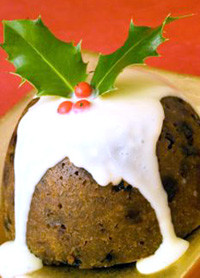 If you have any Canadian friends who are good cooks, they can sometimes
go to the effort to recreate dishes often referred to in Christmas
Carols. Its that whole British thing and “Hey, I’m a Royal Subject,
eh?” But after Pfeffernusse, Sugar Cookies, Flaming Plum and Figgy Pudding,
parties with lavish cheese plates and the holiday Honeybaked Ham, I get
a little toxic.
If you have any Canadian friends who are good cooks, they can sometimes
go to the effort to recreate dishes often referred to in Christmas
Carols. Its that whole British thing and “Hey, I’m a Royal Subject,
eh?” But after Pfeffernusse, Sugar Cookies, Flaming Plum and Figgy Pudding,
parties with lavish cheese plates and the holiday Honeybaked Ham, I get
a little toxic.
I start to crave more than your every day palate cleanser. It’s more like a yen for a culinary high colonic. A clean fresh salad is what my body calls for and I’m always amazed when this happens.
When my kids were young and I’d fret about not being able to get them to eat enough vegetables and fruit, or protein, the ‘experts’ would invariably assure me in that annoyingly supercilious New Age Parenting tone that “They’ll just naturally take the nutrition their bodies need.” Yeah, that was some bullshit. Like they’d just select the carrots and celery from a table with the big bowl of Cheetos.
More Articles ...
Welcome to the new One for the Table ...
Our Home Page will be different each time you arrive.
We're sure you'll find something to pique your interest...


